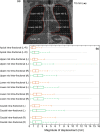Reproducibility of the lung anatomy under active breathing coordinator control: Dosimetric consequences for scanned proton treatments
- PMID: 30229930
- PMCID: PMC6334635
- DOI: 10.1002/mp.13195
Reproducibility of the lung anatomy under active breathing coordinator control: Dosimetric consequences for scanned proton treatments
Abstract
Purpose: The treatment of moving targets with scanned proton beams is challenging. For motion mitigation, an Active Breathing Coordinator (ABC) can be used to assist breath-holding. The delivery of pencil beam scanning fields often exceeds feasible breath-hold durations, requiring high breath-hold reproducibility. We evaluated the robustness of scanned proton therapy against anatomical uncertainties when treating nonsmall-cell lung cancer (NSCLC) patients during ABC controlled breath-hold.
Methods: Four subsequent MRIs of five healthy volunteers (3 male, 2 female, age: 25-58, BMI: 19-29) were acquired under ABC controlled breath-hold during two simulated treatment fractions, providing both intrafractional and interfractional information about breath-hold reproducibility. Deformation vector fields between these MRIs were used to deform CTs of five NSCLC patients. Per patient, four or five cases with different tumor locations were modeled, simulating a total of 23 NSCLC patients. Robustly optimized (3 and 5 mm setup uncertainty respectively and 3% density perturbation) intensity-modulated proton plans (IMPT) were created and split into subplans of 20 s duration (assumed breath-hold duration). A fully fractionated treatment was recalculated on the deformed CTs. For each treatment fraction the deformed CTs representing multiple breath-hold geometries were alternated to simulate repeated ABC breath-holding during irradiation. Also a worst-case scenario was simulated by recalculating the complete treatment plan on the deformed CT scan showing the largest deviation with the first deformed CT scan, introducing a systematic error. Both the fractionated breath-hold scenario and worst-case scenario were dosimetrically evaluated.
Results: Looking at the deformation vector fields between the MRIs of the volunteers, up to 8 mm median intra- and interfraction displacements (without outliers) were found for all lung segments. The dosimetric evaluation showed a median difference in D98% between the planned and breath-hold scenarios of -0.1 Gy (range: -4.1 Gy to 2.0 Gy). D98% target coverage was more than 57.0 Gy for 22/23 cases. The D1 cc of the CTV increased for 21/23 simulations, with a median difference of 0.9 Gy (range: -0.3 to 4.6 Gy). For 14/23 simulations the increment was beyond the allowed maximum dose of 63.0 Gy, though remained under 66.0 Gy (110% of the prescribed dose of 60.0 Gy). Organs at risk doses differed little compared to the planned doses (difference in mean doses <0.9 Gy for the heart and lungs, <1.4% difference in V35 [%] and V20 [%] to the esophagus and lung).
Conclusions: When treating under ABC controlled breath-hold, robustly optimized IMPT plans show limited dosimetric consequences due to anatomical variations between repeated ABC breath-holds for most cases. Thus, the combination of robustly optimized IMPT plans and the delivery under ABC controlled breath-hold presents a safe approach for PBS lung treatments.
Keywords: active breathing coordinator control; interfraction reproducibility; intrafraction reproducibility; nonsmall-cell lung cancer; pencil beam scanning.
© 2018 The Authors. Medical Physics published by Wiley Periodicals, Inc. on behalf of American Association of Physicists in Medicine.
Figures




References
-
- Zhang X, Li Y, Xiaoning P, et al. Intensity‐modulated proton therapy reduces the dose to normal tissue compared with intensity‐modulated radiation therapy or passive scattering proton therapy and enables individualized radical radiotherapy for extensive stage IIIB non‐small‐cell lung canc. Int J Radiat Oncol Biol Phys. 2010;77:357–366. - PMC - PubMed
-
- Lomax AJ. Intensity modulated proton therapy and its sensitivity to treatment uncertainties 2: the potential effects of inter‐fraction and inter‐field motions. Phys Med Biol. 2008;53:1043–1056. - PubMed
-
- Bert C, Grözinger SO, Rietzel E. Quantification of interplay effects of scanned particle beams and moving targets. Phys Med Biol. 2008;53:2253–2265. - PubMed
-
- Lomax A. Particle Radiotherapy In: Rath AK, Sahoo N, eds. Part Radiother Emerg Technol Treat Cancer. 2016:169–194.
MeSH terms
Grants and funding
LinkOut - more resources
Full Text Sources
Other Literature Sources
Research Materials

